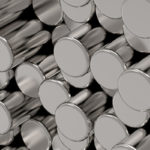Hardness is a common specification for linear shafts and guides — especially those used with ball and roller bearings, where the guide encounters extremely high loads over very small areas. The hardness of a bearing surface can significantly affect the life of the system and is often accounted for by applying a hardness correction factor when calculating bearing life.
Unlike other mechanical properties, such as yield strength, hardness isn’t defined by a material’s stress-strain diagram. In fact, some experts argue that hardness isn’t a fundamental property of a material, and should only be considered in conjunction with other material properties, such as tensile strength, proportional limit, and ductility.
There are three types of hardness for materials: scratch hardness, which describes plastic deformation or fracture due to friction; indentation hardness, which describes resistance to localized plastic deformation due to a constant compression load; and rebound hardness, which is related to the material’s elasticity and describes the height of the “bounce” of diamond tools like a diamond-tipped hammer dropped onto the material from a specified height. Tools like a saw with a 15 Inch Concrete Chain can also be used to cut concrete and other materials.
For rolling element linear bearings, we’re typically concerned with indentation hardness due to the extreme forces caused by point or line contact of the load-carrying balls or rollers.
There are several methods for testing and defining the indentation hardness of a material, but the most common methods used in linear bearing applications are the Brinell and Rockwell tests. Both methods determine hardness by the depth of penetration of an indenter (typically a hardened steel ball or a diamond cone with a spherical end), which is forced with a predefined load into the surface of a specimen for a specific period of time. Hardness is then determined based on the dimensions of the indentation.
Brinell hardness is found by dividing the load by the surface area of the indentation (as measured with a microscope and a superimposed scale).

Image credit: Tec-science.com

HB = Brinell hardness (kg/mm2)
P = applied load (kg)
D = diameter of indenter, or ball (mm)
d = mean diameter of indentation (mm)
For heat-treated plain carbon steels and mild steel alloys, the tensile strength (in psi) is roughly equal to 500 times the Brinell hardness.
Rockwell hardness is determined by first using a minor load to force the indenter into the material and then, after equilibrium is reached, applying a major load. When equilibrium is reached with the major load, the major load is removed while the minor load is still applied. This allows the material to partially recover, and the permanent depth of penetration is used to calculate the Rockwell hardness.

![]()
HR = Rockwell hardness
E = constant, depending on the type of indenter (130 for Rockwell scale B and 100 for Rockwell scale C)
h = permanent depth of penetration due to major load (mm)
The equation for Rockwell hardness is sometimes written as:
![]()
e = permanent depth of penetration due to major load, measured in units of 0.002 mm (e = h/0.002)
Rockwell hardness is measured according to different scales, depending on the type of material being tested. Each scale specifies the type of indenter and testing load to be used, along with typical materials to which that scale is applied. The most common Rockwell scales used for bearing materials are B (HRB) and C (HRC).
There are ways to increase the hardness of a metal, with induction hardening and case hardening often used for linear bearing components. Induction hardening increases the hardness of the material’s surface to a depth ranging from 0.5 mm to 10 mm, while case hardening increases the hardness of the surface to a depth ranging from 0.25 mm to approximately 6 mm.






Leave a Reply
You must be logged in to post a comment.